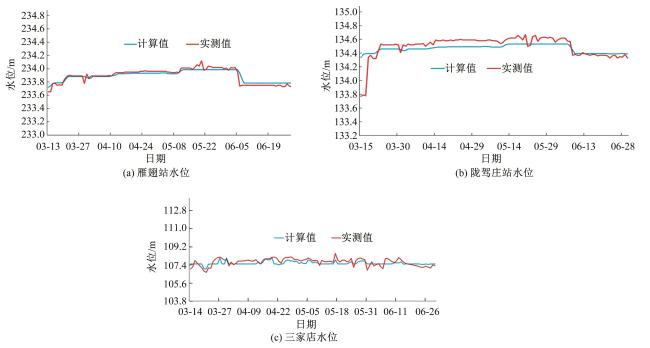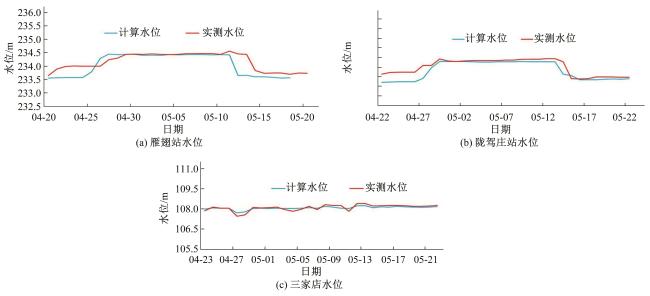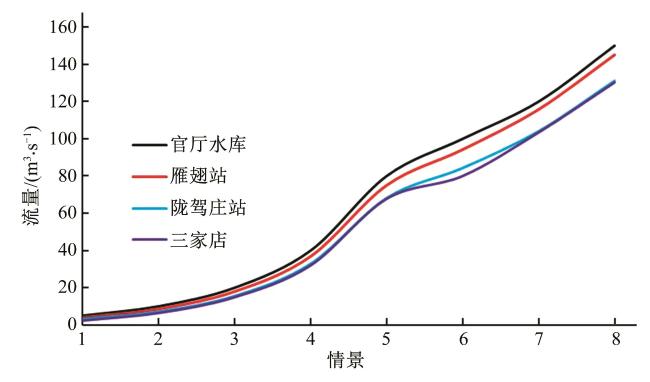 PDF(2573 KB)
PDF(2573 KB)


永定河(北京段)河道生态补水效益分析与方案评估
孙冉, 潘兴瑶, 王俊文, 任宇, 杜鹏, 马尧, 邢渊
 PDF(2573 KB)
PDF(2573 KB)
永定河(北京段)河道生态补水效益分析与方案评估
An Analysis and Evaluation of Ecological Water Replenishment Benefit of Yongding River (Beijing Section)
为了更加科学地制定北方断流河道的生态补水方案,选取常年断流河道永定河北京段为研究区,基于构建的河道水力学模型,模拟分析研究区2019年和2020年两次生态补水过程,量化了生态补水过程中蒸发和渗漏损失量约占20%。官厅水库补水流量越大,下游各断面峰值流量的削减率越小,为减小流量损失,提高补水流量利用率,在水源相对充足的条件下,建议补水流量介于40~80 m3/s之间,同时采取小流量和大流量交替补水的方法,将流域生态补水效益实现最优化。
In order to formulate the ecological water replenishment plan of northern cut-off river more scientifically,this paper takes the Beijing section of the Yongding River as the research area. Based on the established channel hydraulics model, it simulates and analyzes the ecological water replenishment process of the study area in 2019 and 2020, and quantifies the amount of evaporation and leakage loss during the ecological replenishment process accounting for about 20%. The larger the replenishment flow of Guanting Reservoir, the lower the reduction rate of the peak flow of each downstream section. In order to reduce the flow loss and improve the utilization rate of the replenishment flow, it is suggested that the replenishment flow should be between 40~80 m3/s under the condition of relatively abundant water source, and the method of alternating small flow and large flow replenishment should be adopted at the same time. Under the condition of limited water source, the alternations of high-flow and low-flow water replenishment can be considered proper to realize the optimization of ecological water replenishment benefit in the basin.
河道断流 / 生态补水 / 水力学模型 / 效益评估 / 永定河 {{custom_keyword}} /
channel cut-off / ecological replenishment / hydraulics model / benefit assessment / Yongding River {{custom_keyword}} /
表1 数据来源Tab.1 Data sources |
| 参数 | 来源 | 属性(备注) |
|---|---|---|
| 流域边界 | 由30 m精度DEM提取得到 | 1 km×1 km网格 |
| 地形 | 由30 m精度DEM提取得到 | 1 km×1 km网格 |
| 河网水系 | 由30 m精度DEM提取得到 | 1 km×1 km网格 |
| 土壤类型 | HWSD土壤数据库 | Shape文件 |
| 植被类型 | 基于Landsat TM的土地利用图 | 网格文件 |
| 雨量站分布 | 泰森多边形法 | 1 km×1 km网格 |
| 降水 | 气象观测 | 13站 |
| 蒸发 | 气象观测+彭曼公式 | 13站 |
| 流量 | 水文观测 | 5站 |

图3 2019年生态补水模拟水位定结果Fig.3 Simulation results of water level for ecological replenishment in 2019 |
表2 2019年生态补水模型计算水位与实测对比Tab.2 Comparison between calculated water level and measured water level of ecological replenishment model in 2019 |
| 断面 | 计算水位值 (均值)/m | 实测水位值 (均值)/m | 绝对误差/m | 相对误差/% | NSE | RMSE |
|---|---|---|---|---|---|---|
| 雁翅 | 233.892 | 233.894 | -0.002 | 0.001 | 0.863 | 0.039 |
| 陇驾庄 | 134.464 | 134.484 | -0.020 | 0.015 | 0.782 | 0.120 |
| 三家店拦河闸 | 107.570 | 107.910 | -0.340 | 0.320 | 0.580 | 0.300 |
表3 河道分段糙率赋值表Tab.3 Roughness assignment of channel segments |
| 河流分段 | 糙率系数 | 入渗系数/(m |
|---|---|---|
| 官厅水库-珠窝水库 | 0.035 | 0.017 |
| 珠窝水库-雁翅站 | 0.029 | 0.302 |
| 雁翅站-落坡岭水库 | 0.020 | 0.029 |
| 落坡岭水库-下苇甸 | 0.015 | 0.051 |
| 下苇甸-三家店拦河闸 | 0.050 | 0.051 |
| 三家店拦河闸-卢沟桥拦河闸 | 0.045 | 0.010 |
| 卢沟桥拦河闸-黄良铁路 | 0.025 | 0.017 |

图4 2020年生态补水模型水位验证Fig.4 Water level verification of ecological replenishment model in 2020 |
表4 2020年生态补水模型计算水位与实测对比Tab.4 Comparison between calculated water level and measuredwater level of ecological replenishment model in 2020 |
| 断面 | 计算水位值(均值)/m | 实测水位值(均值)/m | 绝对误差/ m | 相对误差/ % | NSE | RMSE |
|---|---|---|---|---|---|---|
| 雁翅 | 234.080 | 234.140 | -0.06 | 0.026 | 0.622 | 0.21 |
| 陇驾庄 | 134.653 | 134.797 | -0.144 | 0.110 | 0.763 | 0.22 |
| 三家店拦河闸 | 108.050 | 108.106 | -0.056 | 0.052 | 0.778 | 0.12 |

图7 不同官厅水库补水情景下游各断面峰值流量Fig.7 Peak flow of each section downstream of different Guanting reservoirs under different water replenishment scenarios |
| 1 |
崔建军,郑振华,张韬.河北省太行山区水库下游河道生态恶化特征及成因分析:以滹沱河下游河道为例[J].中国集体经济,2015,21(3):59-60.
{{custom_citation.content}}
{{custom_citation.annotation}}
|
| 2 |
纪玉琨,武春侠,朱毕生.新时期永定河流域生态修复思考[J].水利发展研究,2018(11):31-34.
{{custom_citation.content}}
{{custom_citation.annotation}}
|
| 3 |
李昂,刘定湘.河湖长制立法完善思考[J].水利发展研究,2020(6):9-11,31.
{{custom_citation.content}}
{{custom_citation.annotation}}
|
| 4 |
徐震,赵进勇,李庆国,等.玉符河干流生态适宜流量与生态补水效应分析[J].中国农村水利水电,2018(6):79-83.
{{custom_citation.content}}
{{custom_citation.annotation}}
|
| 5 |
杨卫,许明祥,李瑞清,等.面向生态环境的河湖连通引水调控方案研究[J].武汉大学学报(工学版),2020,53(10):861-870.
{{custom_citation.content}}
{{custom_citation.annotation}}
|
| 6 |
李计生,于海超,张扬,等.基于Tennant改进法的讨赖河生态流量分析与评价[J].节水灌溉,2020(8):72-75.
{{custom_citation.content}}
{{custom_citation.annotation}}
|
| 7 |
杨柠.永定河引黄生态补水长效机制初步探索[J].水利发展研究,2020(2):13-16.
{{custom_citation.content}}
{{custom_citation.annotation}}
|
| 8 |
张琳.民国以来永定河流域北京段生态环境变迁研究[D].北京:北京林业大学,2015.
{{custom_citation.content}}
{{custom_citation.annotation}}
|
| 9 |
刘家宏,梅超,向晨瑶,等.城市水文模型原理[J].水利水电技术,2017(5):1-5,13.
{{custom_citation.content}}
{{custom_citation.annotation}}
|
| 10 |
卢慧,董红霞,轩晓博.基于减水河MIKE11建库后对水环境的影响[J].水科学与工程技术,2018,18(6):20-22.
{{custom_citation.content}}
{{custom_citation.annotation}}
|
| 11 |
潘兴瑶,李其军,陈建刚,等.城市地区流域洪水过程模拟:以清河为例[J].水力发电学报,2015,34(6):71-80.
{{custom_citation.content}}
{{custom_citation.annotation}}
|
| 12 |
杨勇,谷健芬,李元春.永定河长时放水条件下的入渗能力及影响范围分析[J].工程勘察,2019,37(6):29-35.
{{custom_citation.content}}
{{custom_citation.annotation}}
|
| 13 |
刘易庄,杨树清,蒋昌波.洞庭湖萎缩对湖内洪水影响[J].水科学进展,2019,30(4):485-495.
{{custom_citation.content}}
{{custom_citation.annotation}}
|
| 14 |
史源,章少辉,白美健,等.欧拉法融合拉格朗日法高效模拟灌溉二维地表水运动规律[J].农业工程学报,2019,35(12):150-156.
{{custom_citation.content}}
{{custom_citation.annotation}}
|
| 15 |
张敏秋.北京市永定河“五湖一线”综合治理思路与经验启示[J].水利规划与设计,2016,17(2):7-8,20.
{{custom_citation.content}}
{{custom_citation.annotation}}
|
| {{custom_ref.label}} |
{{custom_citation.content}}
{{custom_citation.annotation}}
|
 PDF(2573 KB)
PDF(2573 KB)
 图1 永定河流域研究区示意图
图1 永定河流域研究区示意图 表1 数据来源
表1 数据来源 图2 生态补水流量过程线(官厅水库断面)
图2 生态补水流量过程线(官厅水库断面) 图3 2019年生态补水模拟水位定结果
图3 2019年生态补水模拟水位定结果 表2 2019年生态补水模型计算水位与实测对比
表2 2019年生态补水模型计算水位与实测对比 表3 河道分段糙率赋值表
表3 河道分段糙率赋值表 图4 2020年生态补水模型水位验证
图4 2020年生态补水模型水位验证 表4 2020年生态补水模型计算水位与实测对比
表4 2020年生态补水模型计算水位与实测对比 图5 2019年各监测断面流量过程
图5 2019年各监测断面流量过程 图6 2020年各监测断面流量过程
图6 2020年各监测断面流量过程 图7 不同官厅水库补水情景下游各断面峰值流量
图7 不同官厅水库补水情景下游各断面峰值流量 图8 不同情景下游各断面达到峰值流量所需时间
图8 不同情景下游各断面达到峰值流量所需时间/
| 〈 |
|
〉 |